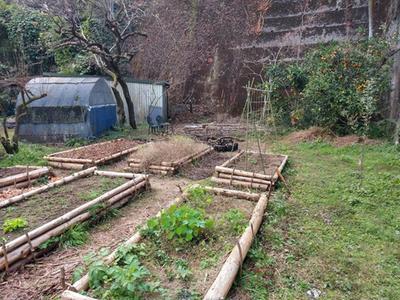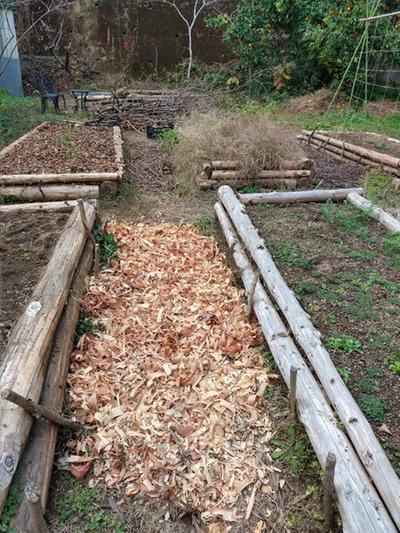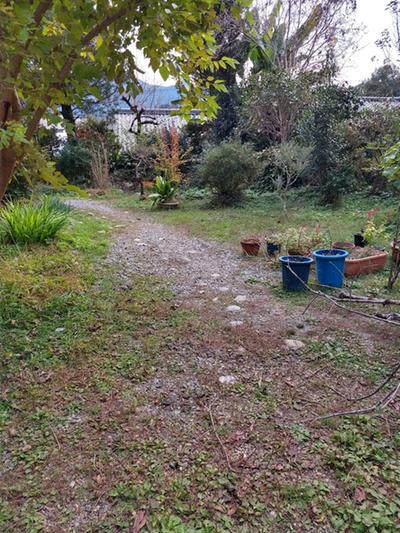The current state of things as of December 2020
This is my vegetable garden with hugelkultur raised beds. I missed the last planting season, so things are more barren than I wish, I just finished planting the few things I still could and I'm only now getting to covering up the unused beds with mulch. I have some volunteer potatoes, nasturtiums, and watercress. Otherwise I've planted lettuce, carrots, spinach, bok choy, peas, and garlic. Many of the seeds were old, so this is kind of a throw-away season for growing, mostly just getting ready for the coming spring planting.
On the right side you can barely make out a couple apple saplings. Behind them are two local citrus trees that grow well here but produce very sour fruit like a lemon, not the go-to choice for a snack. On the left you can see a mature persimmon tree and chestnut tree. I'm doing my best to prune them back so they stop dropping leaves on the roof of that outbuilding and so that I can get more access to their produce. The greenhouse pictured here I am planning to use as a greenhouse in the future, but for now its just storage. The other building was just a storage building that I'm slowly getting ready to turn into a woodshop.

Here is a detail of the lanes between the raised beds. I use the small clippings from trees and wood shavings as a mulch, it is giving me mixed results. Really I need a thicker mulch of more finely chopped materials. But the labor involved in getting that is not worth it, so I get a lot of weeds growing through, especially on the margins. I should plant something I want, but I'm just not on top of it.

Here is an older picture from when I was putting the beds together, you can see the wood I buried under the raised beds.

This is the area where gravel was lain in an attempt to prevent weed growth... but was not maintained or weeded in anyway, creating a gravel/sod mixture that has been one of the biggest annoyances of this plot. Gravel is very popular as a ground cover in Japanese home gardens. This part of the garden is mostly ornamental flowering plants like azaleas, camellia, cherry, magnolia, and the like, and now they do blossom but the appearance is marred by the spotty gravel. The flower pots are my herbs with no home in the ground yet. Most of them I will plant out except the lemon balm and mint, which needs to stay in a pot.

I'll cover other detail areas in future posts. I've been studying the plants growing here for 5 years, and there are hundreds of varieties... Some natural, some introduced.


 12
12
















 4
4








 1
1




























 2
2




![Filename: cherry.jpg
Description: cherry tree [Thumbnail for cherry.jpg]](/t/152566/a/127751/cherry.jpg)
![Filename: ume.jpg
Description: ume [Thumbnail for ume.jpg]](/t/152566/a/127752/ume.jpg)








 2
2




![Filename: persimmon-drive.jpg
Description: [Thumbnail for persimmon-drive.jpg]](/t/152566/a/127755/persimmon-drive.jpg)
![Filename: persimmon-giant.jpg
Description: [Thumbnail for persimmon-giant.jpg]](/t/152566/a/127756/persimmon-giant.jpg)
![Filename: persimmon-gutter.jpg
Description: [Thumbnail for persimmon-gutter.jpg]](/t/152566/a/127757/persimmon-gutter.jpg)
![Filename: persimmon-kitchen.jpg
Description: [Thumbnail for persimmon-kitchen.jpg]](/t/152566/a/127758/persimmon-kitchen.jpg)








